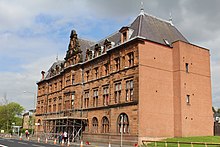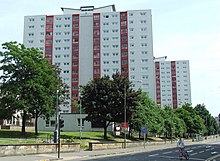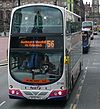For other places with the same name, see Duke Street.
 Former Duke Street Hospital Former Duke Street Hospital | |
| Length | 2.0 mi (3.2 km) |
|---|---|
| Coordinates | 55°51′35″N 4°14′06″W / 55.85978°N 4.23513°W / 55.85978; -4.23513 |
| west end | |
| east end | |
Duke Street is a major street in Glasgow, Scotland, and is of the major road arteries connecting the City Centre to the East End. It begins at High Street and runs east through the residential districts of Ladywell and Dennistoun, and on towards Haghill and Parkhead, meeting the Gallowgate, Tollcross Road and Westmuir Street to form a turreted Edwardian junction at Parkhead Cross. It takes its name from the Duke of Montrose. At a total distance of 2 miles (3.2km), Duke Street is the longest designated street in Glasgow.
From 1460 to 1870, the original buildings of the University of Glasgow were located at the junction of High Street and Duke Street before it moved to the West End. The site was then turned into the College Goods yard by the City of Glasgow Union Railway before it was closed in 1968 in the wake of the Beeching Axe. The wall of the goods warehouse with its distinctive arched windows still faces onto this section of Duke Street, preserved as part of a new office block within the Collegelands development, which also includes a multi-storey car park, student accommodation and a hotel.


Glasgow's infantry barracks was also built adjacent to the University, between Duke Street and the Gallowgate, in 1795. It could accommodate up to 1,000 men but, by the mid-19th century, the buildings were in a dire condition. In 1872, new barracks were completed in the suburb of Maryhill. The site was also used as part of the College goods yard site.
The new Glasgow Meat Market and Abattoir was opened at the corner of Duke Street and Bellgrove Street in Calton, in the 1970s after the original meat market in the nearby Gallowgate, which dated from 1879, closed. It operated for many years as a car auction. The new meat market closed in July 2001 and was demolished in 2007, with new residential developments being constructed on the site. The old market's two listed Victorian entrance archways were retained.
From 1798 to 1957, Duke Street was best known for being the location of Duke Street Prison before it was demolished in 1958, making way for the Drygate (Ladywell) housing estate built on the site from 1961 to 1964. The only remaining structure of Duke Street Prison is some of the boundary wall.

Today, landmarks on Duke Street include the A-listed Ladywell Business Centre, originally designed by John Burnet in 1858 as the Alexanders Endowed School, Tennents' Wellpark Brewery, the nearby Glasgow Necropolis and the A-listed former Sydney Place United Presbyterian Church, which was damaged in a fire but was restored by the Glasgow Building Preservation Trust in 1996 as an extension to the Wellpark Enterprise Centre. There is also a large British Bakeries factory. There was also the Eastern District Hospital, latterly known as Duke Street Hospital, before it closed 1994. The main building was converted into flats, but is now vacant. The area is served by High Street railway station, Bellgrove railway station and Duke Street railway station.
Great Eastern Hotel
The building at 100 Duke St is a fireproof six-storeyed (plus basement) mill built in 1848 for R F and J Alexander, cotton-spinners. The lower 3 floors have brick vaults on a cast-iron frame; the top 3 floors are of mass concrete vaults on corrugated-iron arches, a very early example such a construction.
The mill closed in the early 20 century and in 1908 it was converted into a model lodging house for men. It even boasted a 200 ft roller-skating rink on the top floor. It soon became a refuge for homeless people. The rooms were split into small cubicles with half height partitions and in total housed over 300 perhaps as many as 500 men in squalid conditions.
In the mid 1990s the building was acquired by Milnbank Housing Association and plans were developed to turn the building into flats. It took until 2001 to rehouse all the men and for the hostel to be closed; the building then lay derelict for many years. During this time the roof blew off in a gale in January 2008 and the eastern gable plus 3 bays collapsed in March 2009. Milnbank in partnership with construction firm CCG started work in 2009 to convert the building into 60 flats for private sale, a further 48 for social rent in an adjacent new build, and a new nursery for 75 children. This included the rebuilding of the eastern wing's stone work and windows to the original detailing. The original stained glass windows to the ground floor were reproduced, and car parking was incorporated within the basement level. Funding was a combination of Housing Association Grant (HAG) under the Scottish Government’s Affordable Housing Investment Programme (AHIP), Big Lottery Fund and private funding from the developer's own resources.
See also
References
- "Glasgow, High Street, Old College". canmore.org.uk. Retrieved 4 October 2019.
- Old College (Mitchell Library, Glasgow Collection, late 1660s), The Glasgow Story
- Old College (Mitchell Library, Joseph Swan, 1821), The Glasgow Story
- "TheGlasgowStory: College Goods Station". The Glasgow Story. Retrieved 4 October 2019.
- High Street, 1900 (Mitchell Library, Glasgow Collection, Postcards Collection), the Glasgow Story
- Glasgow, 208 High Street, High Street Goods Station, Canmore
- "Collegelands". Archived from the original on 16 May 2014. Retrieved 10 June 2014.
- Collegelands office scheme opens its doors, Urban Realm, 2 February 2012
- "New Collegelands business and residential site to open in city centre". STV News. 2 February 2012. Archived from the original on 4 January 2019. Retrieved 4 October 2019.
- Glasgow Infantry Barracks
- Memories: Duke Street Ladywell Housing and it rained in 1957, Evening Times, 12 January 2016
- Elizabeth Williamson, Anne Riches & Malcolm Higgs, The Buildings of Scotland: Glasgow. London: Penguin Books 1990. ISBN 0-14-071069-8
- "Kirkhaven/Wellpark". Archived from the original on 7 June 2010. Retrieved 3 September 2009.
- ^ "Glasgow, 100 Duke Street, R F And J Alexander's Cotton Spinning Mill | Canmore". canmore.org.uk. Retrieved 25 October 2024.
- ^ "urbanglasgow.co.uk-The Great Eastern Hotel". urbanglasgow.co.uk. 12 September 2010. Retrieved 25 October 2024.
- ^ "Great Eastern sunset". The Herald. 17 November 1997. Retrieved 25 October 2024.
- "£10m revamp plan won't be hit by storms". Glasgow Times. 18 January 2008. Retrieved 25 October 2024.
- "70ft section of wall falls at Great Eastern". Glasgow Times. 19 March 2009. Retrieved 25 October 2024.
- ^ "£14m blueprint breathes life into Great Eastern". Glasgow Times. 6 July 2009. Retrieved 25 October 2024.
- "Stonemasons in West Scotland : Scotcourt (Stonemasons)". www.scotcourt-stonemasonsltd.co.uk. Retrieved 25 October 2024.
- "Grant Murray". www.grant-murray.co.uk. Retrieved 25 October 2024.
- "Great Eastern Hotel redevelopment nears completion : September 2010 : News : Architecture in profile the building environment in Scotland". Urban Realm. Retrieved 25 October 2024.
External links
![]() Media related to Duke Street, Glasgow at Wikimedia Commons
Media related to Duke Street, Glasgow at Wikimedia Commons


